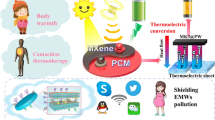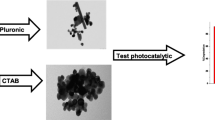Abstract
TiO2 aggregates (TAs) were prepared via combination of facile ‘microwave assisted sol–gel synthesis’ and ‘lyophilization based extraction.’ The rapid hydrolysis followed by peptization of titanium iso-propoxide was carried out under microwave irradiation to form TiO2 hydrosol at temperature as low as 90 °C in just 10 min. Further, lyophilization of the as-synthesized TiO2 hydrosol resulted in the formation of loosely packed TAs. The X-ray diffraction and Raman analysis confirmed the crystallinity of TAs with predominant anatase phase. The transmission electron microscopy images of TAs revealed the interlinked aggregated structure of ~10-nm-sized TiO2 nanoparticles. The scanning electron microscopy images further confirmed the agglomerated structure of TAs with the size ranging from 500 to 1000 nm, which composed of several TiO2 nanoparticles. In addition, the Brunauer–Emmett–Teller (BET) analysis of TAs revealed its mesoporous structure and high specific surface area of 95 m2/g. The photoanode films fabricated with TAs proved for its better dye intake and superior light scattering owing to its high surface area and comparable size with incident wavelength, respectively, which in turn significantly improves the light-harvesting ability. In comparison with standard P25 nanoparticle-based DSSCs, short circuit photocurrent density (J sc) and photoconversion efficiency of TA-based DSSCs showed improvement up to ~35 % under simulated AM1.5 G illumination (100 mW/cm2).








Similar content being viewed by others
References
Green MA, Emery K, Hishikawa Y et al (2015) Solar cell efficiency tables (Version 45). Prog Photovolt Res Appl 23:1–9
Yan J, Saunders BR (2014) Third-generation solar cells: a review and comparison of polymer: fullerene, hybrid polymer and perovskite solar cells. RSC Adv 4:43286–43314
O’regan B, Grätzel M (1991) Low cost and highly efficient solar cells based on the sensitization of colloidal titanium dioxide. Nature 335:737–740
Gonçalves LM, de Zea Bermudez V, Ribeiro HA, Mendes AM (2008) Dye-sensitized solar cells: a safe bet for the future. Energy Environ Sci 1:655–667
Ragoussi M-E, Torres T (2015) New generation solar cells: concepts, trends and perspectives. Chem Commun 51:3957–3972
Park K, Zhang Q, Myers D, Cao G (2013) Charge transport properties in TiO2 network with different particle sizes for dye sensitized solar cells. ACS Appl Mater Interfaces 5:1044–1052
Zhang S, Yang X, Numata Y, Han L (2013) Highly efficient dye-sensitized solar cells: progress and future challenges. Energy Environ Sci 6:1443–1464
Cui Y, Zhang L, Lv K et al (2015) Low temperature preparation of TiO2 nanoparticle chains without hydrothermal treatment for highly efficient dye-sensitized solar cells. J Mater Chem A 3:4477–4483
Koo H-J, Park J, Yoo B et al (2008) Size-dependent scattering efficiency in dye-sensitized solar cell. Inorg Chim Acta 361:677–683
Krishnapriya R, Praneetha S, Murugan AV (2015) Energy-efficient, microwave-assisted hydro/solvothermal synthesis of hierarchical flowers and rice grain-like ZnO nanocrystals as photoanodes for high performance dye-sensitized solar cells. CrystEngComm 17:8353–8367
Li Z-Q, Chen W-C, Guo F-L et al (2015) Mesoporous TiO2 yolk-shell microspheres for dye-sensitized solar cells with a high efficiency exceeding 11%. Sci Rep. doi:10.1038/srep14178
Wang H, Zheng L, Liu C et al (2011) Rapid microwave synthesis of porous TiO2 spheres and their applications in dye-sensitized solar cells. J Phys Chem C 115:10419–10425
Dong Z, Ren H, Hessel CM et al (2014) Quintuple-shelled SnO2 hollow microspheres with superior light scattering for high-performance dye-sensitized solar cells. Adv Mater 26:905–909
Jiang J, Gu F, Shao W, Li C (2012) Fabrication of spherical multi-hollow TiO2 nanostructures for photoanode film with enhanced light-scattering performance. Ind Eng Chem Res 51:2838–2845
Barbe CJ, Arendse F, Comte P et al (1997) Nanocrystalline titanium oxide electrodes for photovoltaic applications. J Am Ceram Soc 80:3157–3171
Hagfeldt A, Boschloo G, Sun L et al (2010) Dye-sensitized solar cells. Chem Rev 110:6595–6663
Zhang Q, Myers D, Lan J et al (2012) Applications of light scattering in dye-sensitized solar cells. Phys Chem Chem Phys 14:14982–14998
Cheng W-Y, Deka JR, Chiang Y-C et al (2012) One-step, surfactant-free hydrothermal method for syntheses of mesoporous TiO2 nanoparticle aggregates and their applications in high efficiency dye-sensitized solar cells. Chem Mater 24:3255–3262
Liu Z, Su X, Hou G et al (2013) Spherical TiO2 aggregates with different building units for dye-sensitized solar cells. Nanoscale 5:8177–8183
Wang X, Tian J, Fei C et al (2015) Rapid construction of TiO2 aggregates using microwave assisted synthesis and its application for dye-sensitized solar cells. RSC Adv 5:8622–8629
Chou H-T, Tseng K-C, Hsu H-C (2016) Fabrication of deformed TiO2 aggregate as photoanode in dye-sensitized solar cells. IEEE J Photovolt 6:211–216
Chen X, Mao SS (2007) Titanium dioxide nanomaterials: synthesis, properties, modifications and applications. Chem Rev 107:2891–2959
Yu J, Zhao X, Du J, Chen W (2000) Preparation, microstructure and photocatalytic activity of the porous TiO2 anatase coating by sol–gel processing. J Sol–Gel Sci Technol 17:163–171
Kim DJ, Hahn SH, Oh SH, Kim EJ (2002) Influence of calcination temperature on structural and optical properties of TiO2 thin films prepared by sol–gel dip coating. Mater Lett 57:355–360
Alphonse P, Varghese A, Tendero C (2010) Stable hydrosols for TiO2 coatings. J Sol–Gel Sci Technol 56:250–263
Muniz EC, Góes MS, Silva JJ et al (2011) Synthesis and characterization of mesoporous TiO2 nanostructured films prepared by a modified sol–gel method for application in dye solar cells. Ceram Int 37:1017–1024
Isley SL, Penn RL (2006) Relative brookite and anatase content in sol–gel-synthesized titanium dioxide nanoparticles. J Phys Chem B 110:15134–15139
Bilecka I, Niederberger M (2010) Microwave chemistry for inorganic nanomaterials synthesis. Nanoscale 2:1358–1374
Dar MI, Chandiran AK, Grätzel M et al (2014) Controlled synthesis of TiO2 nanoparticles and nanospheres using a microwave assisted approach for their application in dye-sensitized solar cells. J Mater Chem A 2:1662–1667
Baghbanzadeh M, Carbone L, Cozzoli PD, Kappe CO (2011) Microwave-assisted synthesis of colloidal inorganic nanocrystals. Angew Chem Int Ed 50:11312–11359
Ding K, Miao Z, Liu Z et al (2007) Facile synthesis of high quality TiO2 nanocrystals in ionic liquid via a microwave-assisted process. J Am Chem Soc 129:6362–6363
Wilson GJ, Matijasevich AS, Mitchell DRG et al (2006) Modification of TiO2 for enhanced surface properties: finite Ostwald ripening by a microwave hydrothermal process. Langmuir 22:2016–2027
Pai KRN, Anjusree GS, Deepak TG et al (2014) High surface area TiO2 nanoparticles by a freeze-drying approach for dye-sensitized solar cells. RSC Adv 4:36821–36827
Zhang H, Banfield JF (2000) Understanding polymorphic phase transformation behavior during growth of nanocrystalline aggregates: insights from TiO2. J Phys Chem B 104:3481–3487
Gribb AA, Banfield JF (1997) Particle size effects on transformation kinetics and phase stability in nanocrystalline TiO2. Am Mineral 82:717–728
Zhang J, Li M, Feng Z et al (2006) UV Raman spectroscopic study on TiO2. I. Phase transformation at the surface and in the bulk. J Phys Chem B 110:927–935
Gupta SK, Desai R, Jha PK et al (2009) Titanium dioxide synthesized using titanium chloride: size effect study using Raman spectroscopy and photoluminescence. J Raman Spectrosc 41:350–355
Golubović A, Šćepanović M, Kremenović A et al (2009) Raman study of the variation in anatase structure of TiO2 nanopowders due to the changes of sol–gel synthesis conditions. J Sol–Gel Sci Technol 49:311–319
Oskam G, Nellore A, Penn RL, Searson PC (2003) The growth kinetics of TiO2 nanoparticles from titanium (IV) alkoxide at high water/titanium ratio. J Phys Chem B 107:1734–1738
Vorkapic D, Matsoukas T (1999) Reversible agglomeration: a kinetic model for the peptization of titania nanocolloids. J Colloid Interface Sci 214:283–291
Bischoff BL, Anderson MA (1995) Peptization process in the sol–gel preparation of porous anatase (TiO2). Chem Mater 7:1772–1778
Shaikh SF, Mane RS, Min BK et al (2016) d-Sorbitol-induced phase control of TiO2 nanoparticles and its application for dye-sensitized solar cells. Sci Rep. doi:10.1038/srep20103
Xu Q, Anderson MA (1991) Synthesis of porosity controlled ceramic membranes. J Mater Res 6:1073–1081
Gao R, Liang Z, Tian J et al (2013) ZnO nanocrystallite aggregates synthesized through interface precipitation for dye-sensitized solar cells. Nano Energy 2:40–48
Lei BX, Zeng LL, Zhang P et al (2014) Sugar apple-shaped TiO2 hierarchical spheres for highly efficient dye-sensitized solar cells. J Power Sources 253:269–275
Lei B-X, Zhang P, Qiao H-K et al (2014) A facile template-free route for synthesis of anatase TiO2 hollow spheres for dye-sensitized solar cells. Electrochim Acta 143:129–134
Magne C, Cassaignon S, Lancel G, Pauporté T (2011) Brookite TiO2 nanoparticle films for dye-sensitized solar cells. ChemPhysChem 12:2461–2467
Acknowledgements
This work was supported by Science and Engineering Research Board, Govt. of INDIA through young scientist Project under the Grant no. SR/FT/CS-164/2011 dated 04-12-2012. D.N.J is grateful to the Ministry of New and Renewable Energy (MNRE) for the fellowship. The authors also acknowledge ‘Central Instrumental Facility,’ Inter-disciplinary Program in Life Science (IPLS) and ‘Department of Bio-technology,’ Pondicherry University for characterization and sample processing facility. The authors are grateful to Dr. C. Sudakar, Associate Professor, and his postdoctoral researcher Dr. P. IIaiyaraja, Multifunctional Materials Laboratory, Department of Physics, IIT Madras, India, for their contribution towards IPCE measurement.
Author information
Authors and Affiliations
Corresponding author
Rights and permissions
About this article
Cite this article
Joshi, D.N., Sudhakar, S., Nair, R.V. et al. Swift sol–gel synthesis of mesoporous anatase-rich TiO2 aggregates via microwave and a lyophilization approach for improved light scattering in DSSCs. J Mater Sci 52, 2308–2318 (2017). https://doi.org/10.1007/s10853-016-0523-2
Received:
Accepted:
Published:
Issue Date:
DOI: https://doi.org/10.1007/s10853-016-0523-2




